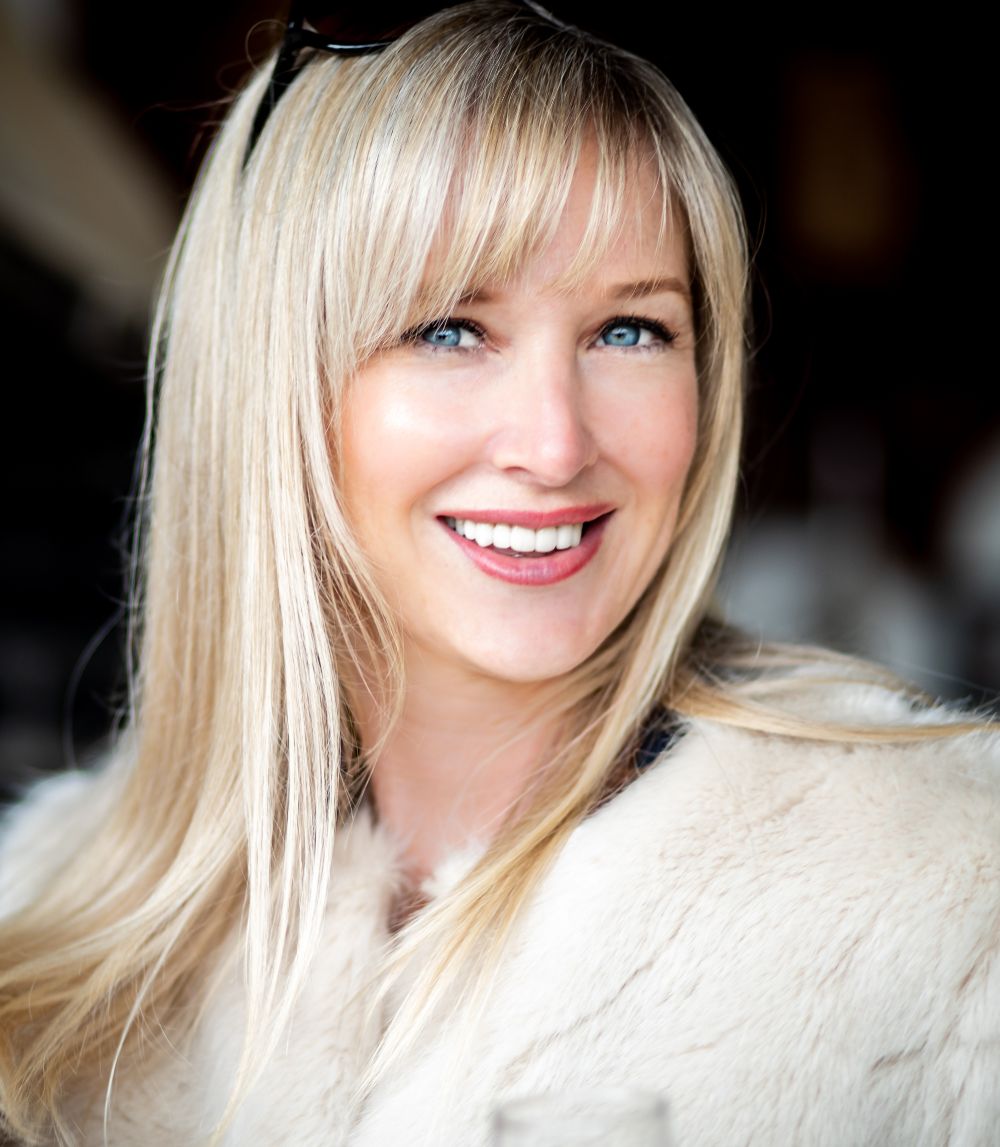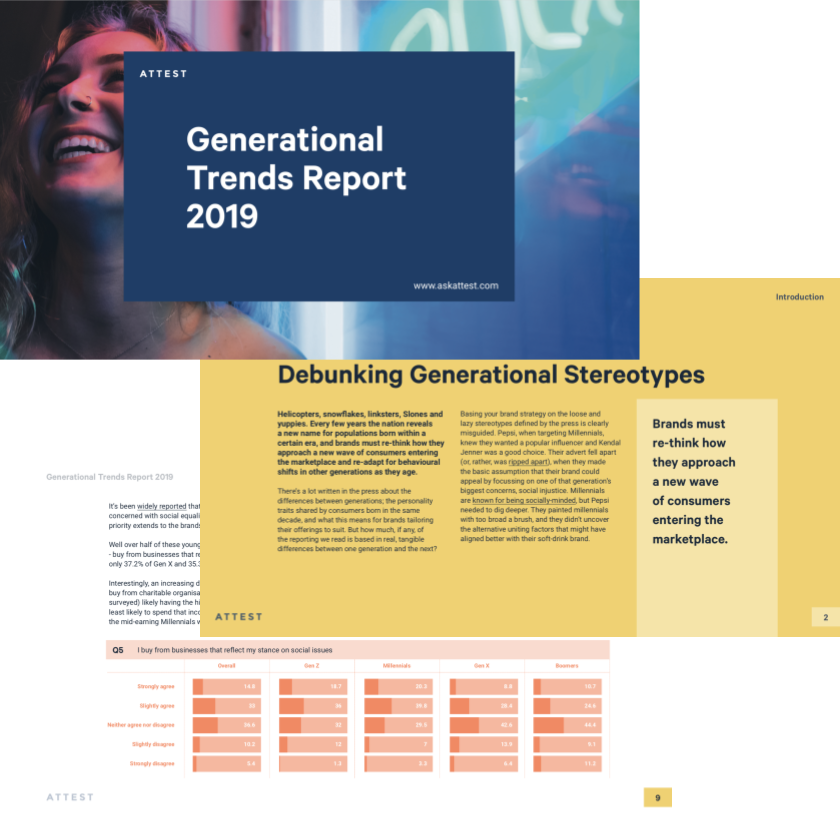Age Is Just a Number: Why Age-Agnostic Marketing Works

What's the appeal of age-agnostic marketing, and who does it well? Get clued up on why age-agnostic marketing works, with real-life examples.
Let’s play a game. What interests would you associate with the following people:
Old lady… knitting
Middle-aged man… golf
Teenage girl… boybands
It’s human nature to draw age-based stereotypes, but how accurate are they these days? When we ran a lifestyle survey of 2,000 consumers in the UK and the US, we found that only 18% of people feel their interests are dictated by their age.
Brands have long made assumptions about people based on their age. Whether it’s kindly old granddads wielding Werthers Originals or moody teenagers who won’t clean their rooms, we’re so used to seeing these archetypes that we think they’re genuinely representative.
But logically we know that people are much more multifaceted. And if you can’t rely on people of the same age to have similar interests, how do you create campaigns to appeal to them?
Leading voices at creative agencies believe we are heading into an era of ‘age-agnostic’ marketing. This means not segmenting on age alone, but rather having a far deeper understanding of your consumers’ psychology.
Age-agnostic marketing: The age of no age
Life expectancy has continued to rise throughout the 20th century, with people now staying fit and active well after retirement age. But it’s not just the older generation who are redefining what it means to be their age – young people are equally keen not to be pigeonholed. Our survey found that 40% of Gen Z (aged 18-24) believe age has no influence on their interests or hobbies. In fact, no group we asked thought age was a major influence on the things they liked.
Boomers (age 55-64), who are typically targeted with ads for funeral plans and portrayed as armchair-dwelling and slipper-wearing, firmly reject the idea that they have become any less passionate about life as they’ve got older. More than 90% of US Boomers and 85% of UK Boomers disagree that their lust for life has been affected by ageing. This data makes it clear that brands must rely on insight not instinct when deciding what will interest people within specific generations.
Why we need to stop the obsession with youth
It’s a fact that older consumers are often ignored by marketers (unless they’re promoting an age-related product). According to a report by Nielsen and BoomAgers, less than 5% of advertising is geared towards people over 50.
There remains an obsession with Millennials and Gen Z, with a damaging belief that including anyone older in marketing campaigns will devalue brands and make them less appealing to younger shoppers.
Speaking at the NextM conference in Copenhagen, Bob Hoffman, former CEO of ad firm Hoffman Lewis, said marketing strategy must be updated to reflect changing global demographics.
“While everyone in marketing is obsessed with Millennials we are actually going through one of the greatest demographic changes in human history and it’s being completely ignored,” he said. “In the 1950s there were three times as many people in the world under five as there were over 65, by 2050 there will be twice as many people over 65 as there will be under 5. Our population is changing at an amazing rate.”
Marie Cesbron-Bloomberg, insight and strategy adviser at The Age of No Retirement, which exists to help eradicate age stereotypes, agrees marketing’s love affair with those aged 18 to 34 is a throwback to the past when older people did not represent such a valuable growth sector.
She told Marketing Week that age-agnostic marketing is crucial if brands want to capture a piece of this market: “Brands must not miss the opportunities because for the first time in history, we have a society where five generations are living together.”
According to the Office for National Statistics, there are more than 23 million people aged over 50 in the UK – that’s more than a third of the population, and the number is growing year-on-year. What’s more, Nielsen states these consumers are “marketing’s most valuable generation”, responsible for nearly 50% of all spend on consumer packaged goods.
The new way to segment
When it comes to the demographics that brands use to segment their customers, age usually features prominently. You’ll often hear ad execs stating a campaign has been designed to appeal to women aged between 18 and 30 or men aged 25 to 35. While that might sound reasonably targeted, that’s actually a huge bucket.
David Stratton, General Manager of Marketing for BT’s consumer division, summed it up perfectly when he told Marketing Week: “Prince Charles and Ozzy Osbourne would be grouped together looking at traditional socio-demographics – both males born in England in 1948, have children, remarried and wealthy. Yet lifestyle, beliefs and behaviours clearly differentiate them and provide a more nuanced and accurate view of both as individuals.”
BT has now opted to go age-agnostic in its targeting, segmenting by interest and behaviours instead. For example, tailored advert creative for the brand’s Complete Wifi product is now served based on the type of online activity BT identifies in audiences, not what age group those people fall into.
When you think about it, this type of segmentation makes much more sense – people are not defined by their age, but they are defined by their behaviour, their beliefs and their interests.
It starts with research
One of the main reasons consumers feel unrepresented by brands is because marketers fail to make strong enough efforts to get to know their audience. If you hope to create campaigns that really resonate, it’s not enough to say your core customer is aged 50+ and skews male; you need to dig deeper.
Consumer research offers a great way to do this, enabling people to tell you (in their own words, if you want) who they are, what their lives look like and why they’re interested in your product.
This information lets brands build up complex marketing personas, offering a complete picture of a customer that goes way beyond their age. You can read more about developing personas and how they can be used to inform highly targeted – and highly effective – campaigns in our previous blog.
Your personas play a vital role in the ideation of campaign creative, giving you real insight about what will appeal to your audience so you don’t have to resort to stereotypes. You may choose to disregard age altogether when devising concepts. After all, a viewer’s age is not what’s really important, it’s the fact they’re (for example) passionate about cosmetics and love to try new products or they have adventurous tastes and want to explore new foods.
What does age-agnostic marketing look like?
Another way to look at age-agnostic marketing is to think of it as being inclusive. Most brands these days try to represent people of various backgrounds, cultures, and abilities in their advertising. This inclusivity can just as easily be extended to people of different ages.
When consumers see people who look like they do in advertising it helps them feel represented by brands. Insurance firm Sunlife has found a reliable way to make sure it accurately depicts its customer base – it conducts its own photoshoots each year so it knows what real over 50s look like, instead of relying on stock images.
Another approach is to lead with strong graphic imagery that doesn’t contain people, creating age-neutral designs. A great example of this is M&S’s “food porn” adverts, where the focus is firmly on the food and not the people eating it. Apple also excels at showcasing the design of its tech without passing comment on who its users might be.
3 Examples of effective age-agnostic marketing campaigns
Hamburger Helper targets rap lovers of all ages
Hamburger Helper is a boxed pasta brand that has historically been aimed at mothers. Since the 1970s it has been promoted through homely ads showing women in the kitchen.
A few years ago, brand owner General Mills decided to take a radical new approach, shunning the norm of targeting demographics in favour of focusing on passions such as music or sport.
The company produced an entire Hamburger Helper rap album, with songs titled ‘Watch the Stove’ and ‘Feed the Streets’. As bizarre as it sounds, it worked – the album went viral and sales of the brand went up by 30%.
According to Michael Fanuele, Chief Creative Officer at General Mills, swapping age for interests when it comes to targeting helps to “humanise” brands: “I’ve come to believe that people love brands for the same reason they love people, because they are funny, or smart, or helpful, or curious, or interesting,” she told The Drum.
“But one of the main drivers of attraction is passion. When someone expresses a passion for something it is really attractive and that holds true for brands. When brands express their passion for sport, people who love it respond in kind. There is a simple human alchemy that occurs when brands express their passion, people become passionate about those things in kind.”
Dove launches an age-inclusive ‘Real Beauty Pledge’
Dove has made a name for itself through its efforts to be an inclusive brand – not only does it promote beauty for women of all shapes and sizes, it also recognises that wanting to feel (and look good) is not exclusive to younger people.
In 2017, Dove launched its Real Beauty Pledge promising that its marketing would be reflective of all its customers, regardless of demographic. To do this it would use “real women” in its adverts and not models.
“Models reflect a narrow view of beauty. Dove believes that beauty is for everyone and therefore features real women of different ages, sizes, ethnicities, hair colour, type or style. Our campaigns reflect the population’s diversity,” the brand said.
To mark the launch of the Dove Real Beauty Pledge, renowned photographer Mario Testino photographed 32 portraits of real women and girls, aged 11 to 71, from over 15 countries. The portraits make up part of the Dove Real Beauty Showcase, celebrating 60 years of Dove, which was on display in New York City.
The Dove Real Beauty Pledge is designed to build on the brand’s Campaign for Real Beauty, first launched in 2004. Dove Global Vice President, Sophie Galvani, said: “While the beauty landscape is wildly different to what it was in 2004, our commitment to redefining beauty hasn’t changed. The women and girls photographed celebrate true global diversity; each has her own unique beauty story and is a true inspiration for women everywhere.
“We’ve long admired the work that Mario Testino does and his ability to capture the real beauty in women. We are thrilled to work with him as his status and influence in pop culture makes him a valuable champion in helping to make real and diverse beauty more mainstream.”
Debenhams proves age is no barrier to style
Debenhams has identified a core market of women who do not allow their age to restrict their willingness to experiment with fashion – and they’re called Claire.
Richard Cristofoli, Debenhams’ Marketing Director said finding ‘Claire’ was the culmination of 12-months of “deep-dive” research by Debenhams. The department store has since shifted the focus of its marketing away from age and towards the attitudes of its core consumers.
“The democratisation of social media means that information is everywhere and, for our consumers, this means they are no longer saying: ‘I’m no longer of an age where I should be engaging with certain content,’” Cristofoli told Campaign. “In the past, they would pigeonhole themselves – but that is no longer the case.”
Despite shifting consumer attitudes, the fashion industry continues to focus on Gen Z, leaving the so-called “midult” (grown-up women) feeling unrepresented. “Claire has retained her love for fashion despite what life has thrown at her, but she feels the fashion industry is obsessed with youth,” Cristofoli reckoned.
He added that where Debenhams differs from Dove in its approach to inclusivity for older women is that it’s more aspirational: “When we talk to our consumers, both about the women they admire and the challenges they face in their own life, it is very much about the challenges around family life and career. But it is not just about aspiration in the business world – they are also aspirational about how they look.”
As well as being age-agnostic, Debenhams’ autumn/winter campaign, which featured supermodels Helena Christensen, Yasmin Le Bon and Eva Herzigová, was also channel-agnostic, with 60% of budget spent on social media. According to Cristofoli, research suggests the Claire persona massively over-indexes on mobile. “We need to stop thinking of social media as ‘youth’ platforms,” he said.
A final thought
Creating an age-agnostic campaign might seem too broad, but it doesn’t mean trying to appeal to everyone. It simply means targeting people for reasons other than their age. The year of someone’s birth is going to have less and less relevance as lifestyles continue to evolve. After all, a new mum these days is just as likely to be in her late 30s or early 40s as she is in her 20s.
Marketers need to keep up with changing attitudes – and changing realities – instead of relying on tired age-based stereotypes. No single age group should be treated as a homogeneous group; we’re all individuals. Shifting focus to consumers’ passions and values will help brands extend their appeal across generations.
Want to get to know your consumers and understand trends across generations, but don’t know where to start? Check out our Generational Trends Report for 2019 and get started with debunking generational stereotypes.
Tell us what you think of this article by leaving a comment on LinkedIn.
Or share it on:

